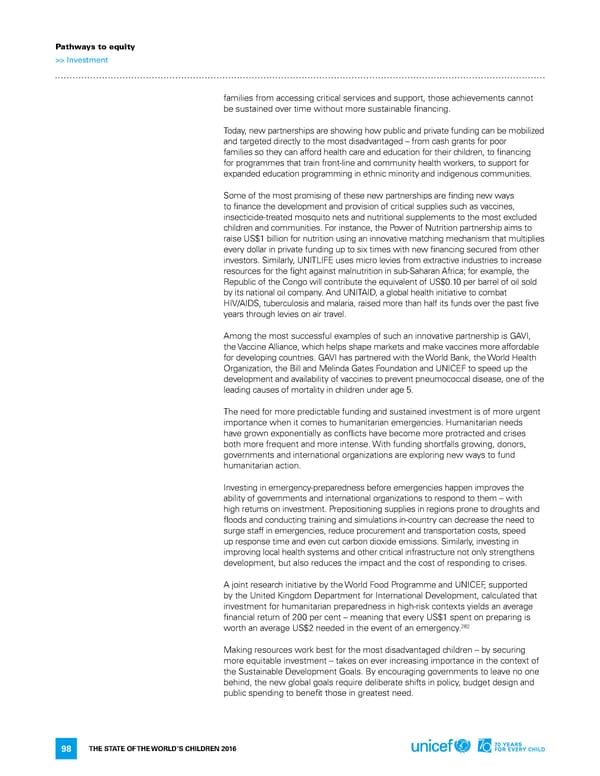Pathways to equity >> Investment families from accessing critical services and support, those achievements cannot be sustained over time without more sustainable financing. Today, new partnerships are showing how public and private funding can be mobilized and targeted directly to the most disadvantaged – from cash grants for poor families so they can afford health care and education for their children, to financing for programmes that train front-line and community health workers, to support for expanded education programming in ethnic minority and indigenous communities. Some of the most promising of these new partnerships are finding new ways to finance the development and provision of critical supplies such as vaccines, insecticide-treated mosquito nets and nutritional supplements to the most excluded children and communities. for instance, the Power of nutrition partnership aims to raise US$1 billion for nutrition using an innovative matching mechanism that multiplies every dollar in private funding up to six times with new financing secured from other investors. Similarly, UniTlife uses micro levies from extractive industries to increase resources for the fight against malnutrition in sub-Saharan africa; for example, the republic of the Congo will contribute the equivalent of US$0.10 per barrel of oil sold by its national oil company. and UniTaid, a global health initiative to combat hiV/aidS, tuberculosis and malaria, raised more than half its funds over the past five years through levies on air travel. among the most successful examples of such an innovative partnership is GaVi, the Vaccine alliance, which helps shape markets and make vaccines more affordable for developing countries. GaVi has partnered with the World Bank, the World health organization, the Bill and Melinda Gates foundation and UniCef to speed up the development and availability of vaccines to prevent pneumococcal disease, one of the leading causes of mortality in children under age 5. The need for more predictable funding and sustained investment is of more urgent importance when it comes to humanitarian emergencies. humanitarian needs have grown exponentially as conflicts have become more protracted and crises both more frequent and more intense. With funding shortfalls growing, donors, governments and international organizations are exploring new ways to fund humanitarian action. investing in emergency-preparedness before emergencies happen improves the ability of governments and international organizations to respond to them – with high returns on investment. Prepositioning supplies in regions prone to droughts and floods and conducting training and simulations in-country can decrease the need to surge staff in emergencies, reduce procurement and transportation costs, speed up response time and even cut carbon dioxide emissions. Similarly, investing in improving local health systems and other critical infrastructure not only strengthens development, but also reduces the impact and the cost of responding to crises. a joint research initiative by the World food Programme and UniCef, supported by the United Kingdom department for international development, calculated that investment for humanitarian preparedness in high-risk contexts yields an average financial return of 200 per cent – meaning that every US$1 spent on preparing is 282 worth an average US$2 needed in the event of an emergency. Making resources work best for the most disadvantaged children – by securing more equitable investment – takes on ever increasing importance in the context of the Sustainable development Goals. By encouraging governments to leave no one behind, the new global goals require deliberate shifts in policy, budget design and public spending to benefit those in greatest need. The STaTe of The World’S Children 2016 98
 70 Years for Every Child Page 115 Page 117
70 Years for Every Child Page 115 Page 117